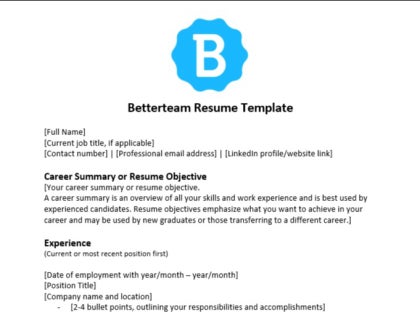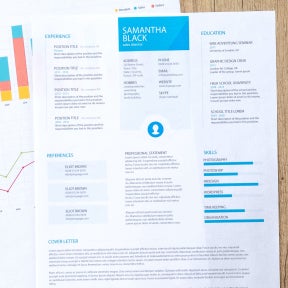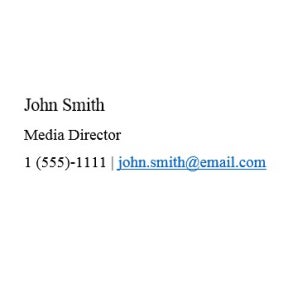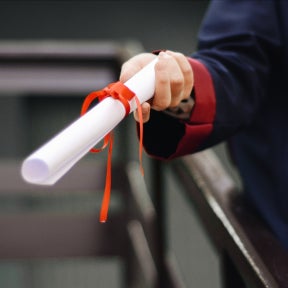
Resume Template
A free resume template that will help you write a quality resume quickly.
Download NowResume Template:
[Full Name]
[Current job title, if applicable]
[Contact number] | [Professional email address] | [LinkedIn profile/website link]
Career Summary or Resume Objective
[Your career summary or resume objective. A career summary is an overview of all your skills and work experience and is best used by experienced candidates. Resume objectives emphasize what you want to achieve in your career and may be used by new graduates or those transferring to a different career.]
Experience (Current or most recent position first)
[Position Title]
[Company name and location] / [Employment dates mm/yyyy – mm/yyyy]
- [2-4 bullet points, outlining your responsibilities and accomplishments]
[Position Title 2]
[Company name and location] / [Employment dates mm/yyyy – mm/yyyy]
- [2-4 bullet points, outlining your responsibilities and accomplishments]
Education
[School or institution name | Location (year started – year ended)]
[Degree name as well as majors/another relevant certificate]
[Special achievements or awards obtained]
[School 2 | Location]
[Degree]
[Achievements/awards]
Skills - [Bulleted list of key skills, relevant to the position. Limit list to between 5 and 10 skills. Include both hard skills soft skills.]
How to Write a Resume:

Follow the steps below to create a resume that is sure to attract the attention of potential employers.
Think about your career goals.
Determine your career objective.

Before you decide on the type of resume you require, you need to know why you're writing the resume in the first place. What kind of position are you applying for and why should the hiring manager give you an interview?
Instead of jumping headlong into the resume writing process, take a moment to analyze your prospective employer's job posting, determine what their needs are, and if you are able to fulfill those needs.
Tailor your resume to the position.

Consider the following before writing your resume:
- Do I have the required qualifications, experience, and skills for this position?
- What positions have I held in the last 10-15 years that are relevant to this new job?
- Do I have any transferable skills my employer should know about?
- Why do I want to work for this company?
- What are my greatest career achievements thus far?
- Are my personal and professional values aligned with those of this company?
- How would this particular job impact my career trajectory?
- What are the significant contributions I've made to the workplace so far?
- Which of my skills and attributes make me an invaluable addition to the company?
Write down the answers to each of the above questions and use them as a guide when you are writing your resume.
Write your resume methodically.
Prepare to write your resume.

If you're writing your very first resume, it's easy to feel overwhelmed by the number of choices available. Do you use a free resume builder to generate your resume, hire someone to compile it for you, or do you write your resume yourself, and if so, which layout do you choose? There are pros and cons to each of these options.
Decide which resume you need.

Before you start writing your resume, you'll have to determine which one would best showcase your experience, skills, qualifications, and career trajectory. Below are the four main resume layouts. With each one, you'll find a downloadable template.
List your personal information.

This is one of the most important sections of your resume. Compile it incorrectly, and the hiring manager might not be able to get in touch with you for an interview. You'll want to include your first and last name, contact number, email address, as well as links to your online portfolio, website, and LinkedIn profile. It is vital that you double-check all the information you provide and make sure none of the links you've included are broken.
Include a professional email address, rather than one that references an embarrassing childhood nickname.
Do not include your work email address or your work contact number. If you can help it, you shouldn't advertise to your colleagues or current boss that you're looking for work elsewhere.
Only include links to your website or blog if it is relevant to your career. For example, a journalist might include a link to their website that showcases articles they've completed over the course of their career, but a medical doctor would not necessarily include a link to their blog on gardening tips. If your website can bolster your chances of employment, include it, otherwise don't mention these details unless you're called for an interview and asked to discuss your hobbies.
Make sure the details on your LinkedIn profile correspond to what you've included in your resume, and if you have a photo on LinkedIn, make sure it's a professional one.
Write a career summary statement.

Sometimes called a resume summary statement, a career summary statement is a short paragraph included at the top of your resume, detailing your most important skills and work experience. It can be thought of as a condensed cover letter and it should quickly highlight all the qualities a hiring manager would be interested in.
Career summaries should be written clearly and accurately, without any buzzwords or unnecessary jargon. This short paragraph will help the hiring manager decide whether to keep reading or not, so take your time to write it.
List your education details.

Depending on the resume template you choose, the position of this section might differ. If you are a recent graduate, you might want to list your qualifications first, whereas work experience would be higher up on the resume of an experienced professional.
How to list education on your resume. If you hold multiple degrees, always list the most recently awarded first. For each qualification, include:
- Name of the school, college, or university, as well as its location.
- Name of the degree or program.
- Years attended and the graduation date.
- Any awards or honors received.
- Any significant research or other contributions you have made to the respective field during your studies.
- Your GPA, provided it's above 3.4.
Example of how to list your education:
University of Georgia | Athens, GA (2016-2020) Bachelor of Arts, majoring in Linguistics and English Literature Dean's Honours List
List your skills.

It might be tempting to cram your resume with all the best skills you can think of, but be selective when you decide what skills to include. Only list skills that are relevant to the positions you are applying for. Every candidate's skill section will look different.
Limit your list to between 5 and 10 relevant skills.
Be honest and don't include things that aren't actually skills.
Don't include old or outdated software.
Include both hard and soft skills.
Do not include irrelevant skills, or confuse skills with hobbies.
Do not lie or exaggerate.
Write about your experience.

Unless you're a graduate with no work experience, this section is the most crucial part of your resume. Your work experience, more so than your skills and qualifications, give employers an idea of your abilities and potential. The number of positions you've held and the type of work you've done will dictate how your experience section looks.
Only include work experience relevant to the position you are applying for.
Be selective when you decide which jobs you include, and only list positions you've held in the last 15 years. The more recent, the better.
Internships, volunteer work, paid, and unpaid jobs all count. Just make sure they are relevant.
Rather than listing your duties, list your achievements. These may be obvious achievements like a promotion or an award, but they can also be less obvious, like improving the efficiency of the call center by optimizing workflows. You'll want to think carefully about the impact you made at your previous workplace.
Include precise dates, including months and years, when you started and ended your jobs.
Be honest about gaps in your career. Periods of unemployment do not necessarily hurt your chances of re-employment.
Example of a Career Summary Statement:
Accomplished Creative Writer with four published books, over twenty years of industry experience, and an excellent track record writing content for online magazines and digital media. Created informative, engaging articles for numerous local and international publications. Increased number of annual Cosmopolitan subscriptions by over 30% in the space of four years working as the editor. Deadline-driven, skilled, and innovative.
The above Summary Statement is from a resume submitted for an Editor. What follows is a breakdown of what makes this a great opening paragraph for a resume:
- The first sentence provides an overview of the candidate, her career highlights, and her experience.
- She chooses her words with care, including only the most pertinent information.
- She lists achievements, but also provides statistics to back them up.
- She gets to the point quickly and concludes by listing her three most important attributes.
What if I haven't completed my studies?
You should still include the details of your degree even if you haven't graduated yet. This is important information for your employer to know, and you'll want to list it towards the top of your resume, under in-progress education. Here's what to include when listing your unfinished degree on a resume:
- The name of your institution and degree.
- The courses you are taking (if relevant).
- Any honors or awards you have received.
- Societies you belong to or extra-curricular activities.
- Your GPA, if higher than 3.4.
- Your intended year of graduation.
How to list your work experience on a resume.
Once you have decided on your three or four most relevant positions, you can go ahead and list them under the experience section of your resume. In reverse-chronological order, list the most recently held positions first.
What to include when listing work experience:
- The exact period during which each position was held, formatted with the year and the month.
- The name of the position held.
- The name of the company and its location.
- A description of 3-5 bullets, detailing the responsibilities of each position.
- Top accomplishments for each position.
- Where possible, include percentages or statistics to bolster your achievements.
Example of how to list experience on a resume:
Experience: 2016-01 - Present Head English Teacher East Greenwich High
- Taught English to grades 9 through 12, covering the entire syllabus, from language studies to literature.
- Taught AP English and trained the top students for the Scripps National Spelling Bee.
- Improved class averages by around 20-30%.
- Won Teacher of the Year Award in 2020 and 2021.
Below is a brief analysis of what makes the above experience section effective:
- The candidate has included only jobs held within the last 15 years.
- She gives a brief account of the key duties performed at each school.
- There's a gap of one year on her resume, but she doesn't try to hide it.
- The information is concise, easy to read, and formatted appropriately.
Additional Resources.
Need to write a CV? See How to Write a CV. Wondering if you need a CV or a resume? See our guide to CVs vs resumes.
Next, put together your references page.
Study this list of action verbs for resumes to prepare for writing.
Learn How to Write a Cover Letter and see our list of the Best Cover Letter Generators.


